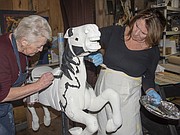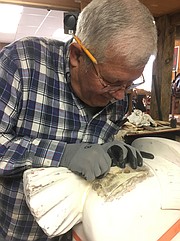Volunteers breathe life back into carousel ponies
SANDPOINT — At nearly 100 years old, the Carousel of Smiles’ ponies are coming back to life.
Community volunteers are breathing life back into the ponies as each one is restored, from the hand-carved woodwork to the colorful paint that gives each one its unique personality.
Clay and Reno Hutchison, who saved the 1920s Allan Herschell carousel from being broken up and sold at auction when they purchased the entire machine in 2000, said it is because of the enthusiasm and talent of the many volunteers that the inside of the ponies — which are typically much more plain than the outer, more visible side — are much more elaborate than you would typically see.
“The artistry is a much higher degree than what would have come out of the factory,” Clay Hutchison said. “These are true art pieces on a working carousel.”
About 15 of the 36 ponies are in various stages of painting, with a few just about ready for the final step — clear coat. There are four stages, however, in the process of restoring a pony, with more than 200 hours going into each one from start to finish. Clay Hutchison said their primary methodology mandate is to “restore rather than replace.”
“We make every effort to save and restore the original wood and character of these almost 100-year-old carvings, even if it would be easier and more expedient to replace degraded parts with new wood,” he said. “We also work to preserve some of the character related to their age, leaving some of the ‘wrinkles’ that come with age. We are fully restoring them, but not back to porcelain-like perfection; they are hand carved wood ponies after all.”
The first stage of restoration includes stripping of the old paint and old repairs, analysis, and deconstruction of the pony.
Of the 36 ponies, all but two were previously stripped of paint, Clay Hutchison said, but all have had numerous repairs required over the years of their operating life. Part of the process includes removal of the head and neck of each pony, which is why the group of volunteers who do the job have been dubbed the Godfather Squad.
Dave Smith, one of the Godfather Squad volunteers, said they dismantle the horses, taking all of the metal out and repairing anything that has been broken. They take the legs, tail, head and neck off of each one, pulling all the nails and screws the carnival operators put in them over the years during repairs.
Then begins stage two, which is reconstruction. Smith said they use dowels and wood shims, and glue everything back together using epoxy.
“We are finding out there is more involved than just putting them back together,” Smith said. “There are so many imperfections that have to be covered up in order for them to get a nice smooth paint coat on them.”
Therefore, once everything is back together, the second stage also includes filling the cracks, as well as repairs to dings and lost detail, Clay Hutchison said, adding that there is “lots and lots” of sanding in preparation for the third stage — primer.
After completion of the wood restoration, Clay Hutchison said the pony receives its first coat of primer. With this consistent color, all of the remaining flaws and issues that could not be detected before, become apparent. An automotive-type spackle, or other spackling product, is then used to fill the dings and sometimes smooth out the laminated joints, he said. The pony is reprimed and the process is repeated, often three times. The Hutchisons said local company Satisfaction Painting is part of the team that “enthusiastically” volunteered to participate in this stage of the project, as it is similar to the prep work they do on older homes.
Finally, it is time for the fourth stage — painting the ponies. This group of volunteers is known as the “Painters of the Lost Arts,” as they seek to bring back the colorful personalities of the ponies. With the help of grants from local organizations, including the Community Assistance League and Selkirk Association of Realtors, a series of workshops have been held for the volunteers.
Bette Largent, curator of the Spokane Looff Carrousel, has over 30 years of experience as a carousel preservationist and horse/animal painter, has been involved in saving and restoring dozens of carousels around the country and abroad, and has painted hundreds of carousel horses and menagerie animals. Largent has led the painting workshops, helping to establish some of the color schemes and techniques, but has largely let the local volunteer artists do the work.
During a workshop in mid-November, Largent said she doesn’t expect to come back until spring. She has trained enough of the artists, she said, that they can help others.
“They can carry on,” she said. “They have learned a lot.”
One of the most important things when it comes to painting is to “get it right.”
“If you don’t get it the way you want it to look, it will haunt you forever,” Largent said.
It is for that reason, Reno Hutchison said the ponies that are done, are not really done, at least not until they give in and put the clear coat on. Until then, the painting and touch ups are an ongoing process.
Each of the ponies is being painted with great detail, right down to their “socks.” Sydney Icardo, one of the local volunteers painting the ponies, has even become known among the group as the “sock lady,” for focusing on that detail, though she said paints the bodies of the ponies as well.
Icardo and the others radiated the enthusiasm the Hutchisons spoke of as they recounted their part in giving life to the carousel ponies. Icardo said she first fell in love with the carousel when she took her dad to the first unveiling of the machine in the building that now houses Matchwood Brewing.
“I just fell in love with the ponies and knew I had to be a part of it from the start,” Icardo said, adding that she would love to see it at City Beach someday. “It would be such an asset, and it would be so great to have my kids and grandkids ride these ponies at the City Beach … We just want as many people as possible to fall in love with these ponies as much as we have.”
Smith said as a jack of all trades, he has enjoyed the different aspects of the woodworking project as it is “very unique.”
“It has been good for me because I retired and was at a point in my life where I needed something to do, so it fit right into my schedule,” Smith said.
For Largent, it is about working with the community. She enjoys working with different communities, she said, as she grew up in a family that was very community-oriented. And to have the community take the carousel and make it their own gives her joy.
“It gives the community ownership, and you can’t take that away,” Largent said. “Then you have to give the carousel its soul, which is to ride it, to enjoy it.”
Reno Hutchison said they have more than 200 people signed up to volunteer. While they have not been able to utilize the full talent pool, she said it is a long-term project and there may still be opportunity in the future for those signed up as the carousel restoration moves forward.
Anyone who banks at the Sandpoint branch of Mountain West Bank may have noticed the display currently set up with a few of the painted ponies, and one of the unrestored chariots that has a newly-painted panel done by volunteer and local artist Jeff Rosencrans. The Hutchisons said they will be bringing over six more of the ponies in various stages of restoration on Thursday for a champagne reception, where the community is invited to see the “process and progress of the pretty painted ponies.”
The reception will begin at 6:30 p.m. Thursday at MWB, 1323 Highway 2, Sandpoint.
Information: thecarouselofsmiles.org



















